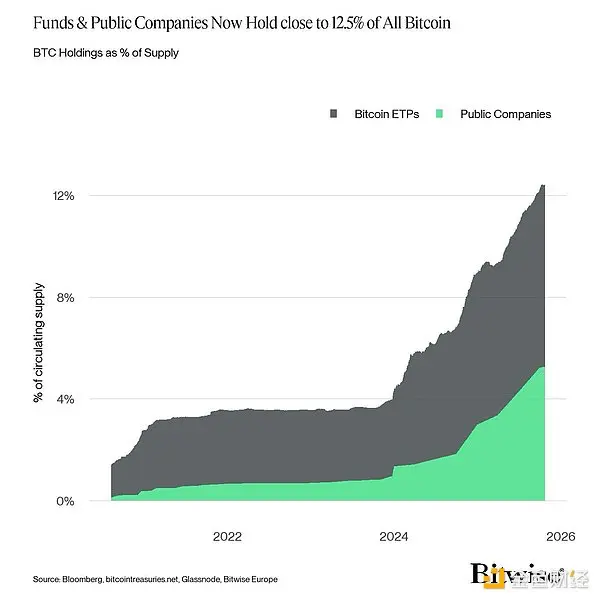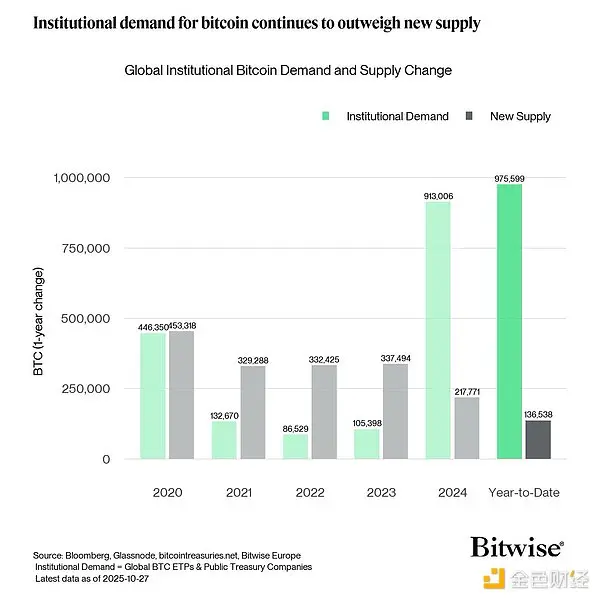Authors: André & eacute; Dragosch, Head of Research for the European Region of Bitwise; Translator: Gold Ziaozou
"If you have any doubts, pull a long axle."
This is the key graph essence of our latest Bitwise quarterly market report。

The data clearly reveal the prevailing trends and can even explain the specificity of the bitcoin cycle of the current round (data provided by River)。
One, read the essence of "The Great Transfer of Wealth."
The core key point is that Bitcoin is moving from early bulk investors to institutional investors (fund/exchange traded products), enterprises and even government entities。
UNLIKE OTHER TRADITIONAL ASSET CLASSES IN HISTORY, BITCOIN ' S PENETRATION PATH BEGINS WITH SCATTERED INVESTORS SUCH AS PASSWORD PUNKS AND EARLY PARTICIPANTS, FOLLOWED BY THE FIRST PLACEMENT OF INSTITUTIONAL INVESTORS SUCH AS FAMILY OFFICES, FUND MANAGERS AND ETFS。
EVEN SO FAR, THE SHARE OF BULK INVESTORS IS STILL ABOUT 66 PER CENT, MEANING THAT THE VAST MAJORITY OF BITCOIN REMAINS IN THE HANDS OF NON-INSTITUTIONAL INVESTORS (SEE MATRIX DISTRIBUTION ABOVE). IN COMPARISON, THE LATEST DATA FROM THE UNITED STATES 13F DOCUMENT SHOW THAT THE ALLOCATION OF INSTITUTIONAL INVESTORS IN TRADITIONAL ASSET CLASSES IS SIGNIFICANTLY HIGHER。
(A) THE PROPORTION OF INSTITUTIONS OBSERVING THE TRADITIONAL ETF:
- iShares ETF (TLT) institutions with a 20-year or more national debt hold 79 per cent
- SPDR 500 ETF (SPY) INSTITUTIONAL HOLDING 58 PER CENT
- SPDR GOLD ETF (GLD) AGENCY HELD 36%。
A comparison with the latest survey of Global Fund managers in United States banks: the current average allocation of encrypted assets (including bitcoin and other currencies) is only 0.4 per cent. (additional: IBIT ' s agency hold ratio is currently only 26% & hellip; …)
As can be seen, institutional adoption is still in its infancy, as the industry used to say, "We are still in our early stages"。
But it is undeniable that a massive transfer of wealth from the diaspora to institutions is taking place. The multiple effects of wealth migration, from early currency spreads to institutional investors, may be far-reaching:
Bitcoin penetration: trends and cyclical patterns
(1) Trends
First, it is clear that this shift will not take place overnight, but will be a long-term trend。
The reality is that most of the bitcoin is non-mobile and is being held for a long time. Only about 14.5 per cent of the supply of bitcoin is kept in relative liquidity on exchanges such as Coinbase or Currency Security, while the remaining assets are stored below the chain in a non-current state。
Without economic incentives, Bitcoin wealth does not automatically shift。
MANY EARLY HOLDERS SET PSYCHOLOGICAL PRICES (E.G. $1 MILLION/BTC) OR ECONOMIC TARGETS (E.G., "HOUSE PURCHASE MONEY") AS TRIGGERS FOR THE SALE OF BITCOIN, WHICH IS MUCH HIGHER THAN THE CURRENT MARKET PRICE OF APPROXIMATELY $115 MILLION. TO ATTRACT THESE NON-CURRENT TOKENS TO MARKETS (I.E. EXCHANGES), BITCOIN PRICES NEED TO RISE SIGNIFICANTLY。
In this process, the spread of bitcoin will be expanded as ETF holds assets in trust for millions of individual investors. The financial statements of listed companies also show that they are being held by hundreds of thousands of different investors. At the time of writing, institutional investors (ETP and listed companies) had controlled about 12.5 per cent of the supply of bitcoin — — and were still rising rapidly。

(2) Periodicity
Most analysts may agree that the early Bitcoin cycle was dominated by a halving event per 210,000 blocks (approximately four years), a mechanism that halved the output of Bitcoin (thus known as "half"。
but the impact of halving events is decreasing with each event — — both in absolute terms and in proportion to the volume of supply in circulation. as institutional adoption rates have risen and demand structures have changed, the effect of halving has diminished significantly。
Data for 2025 show that institutional demand has reached about seven times the supply gap caused by halving demand

in this process, the influence of traditional macro cycles has increased relatively; — bitcoin has become a real "macro asset"。
Our quantitative analysis also shows that more than 80 per cent of the price volatility of bitcoin over the past six months has been driven by macro-factors such as global growth expectations, monetary policy and less than 5 per cent of the impact of token-specific factors。
However, the dominance of macro-factors also means that future Bitcoin cycles will fluctuate in step with the macro/business cycle, and a four-year cycle driven by "half" is likely to be "defunct"。
this ultimately shows that the accumulation and distribution of bitcoin will depend on the dominant macro-environment (extension/shrump/recession) and thus trigger short-term price increases and fluctuations in the risk preference/risk aversion model。
3. Concluding remarks
the fundamental meaning of the term "big shift of wealth" is that bitcoin prices need to be higher — — far above the current levels — — to stimulate further diffusion and complete the transfer from early ostracism to institutional investors。
The continued influx of institutional investors means that bitcoin has become a true "macro asset", and portends that future cycles of bulls and bears will increasingly be dominated by macro-business cycles (rather than by halving events)。